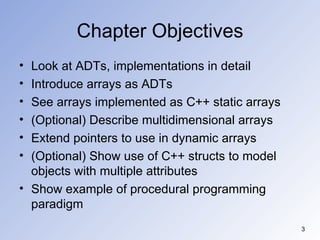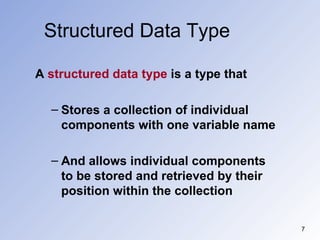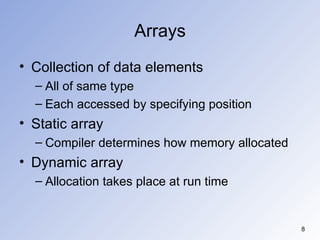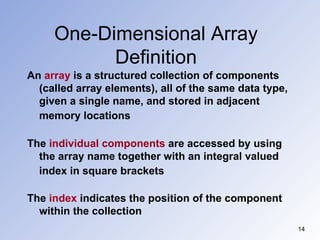Lec2&3_DataStructure
- 1. Data Structures and Abstract Data Types Chapter 2
- 2. Chapter Contents 1 Data Structures, Abstract Data Types and Implementations 2 Static Arrays 3 Multidimensional Arrays (optional) 4 Dynamic Arrays 5 C-Style Structs (optional) 6 Procedural Programming
- 3. Chapter Objectives Look at ADTs, implementations in detail Introduce arrays as ADTs See arrays implemented as C++ static arrays (Optional) Describe multidimensional arrays Extend pointers to use in dynamic arrays (Optional) Show use of C++ structs to model objects with multiple attributes Show example of procedural programming paradigm
- 4. Data Structures, Abstract Data Types, and Implementations Consider example of an airplane flight with 10 seats to be assigned Tasks List available seats Reserve a seat How to store, access data? 10 individual variables An array of variables
- 5. Data Structures, Abstract Data Types, and Implementations Implementation consists of Storage (data) structures Algorithms for basic operations Note following figure C++ provides large collection of data types and structures
- 6. C++ Data Types structured array struct union class simple integral enum char short int long bool address pointer reference floating float double long double
- 7. Structured Data Type A structured data type is a type that Stores a collection of individual components with one variable name And allows individual components to be stored and retrieved by their position within the collection
- 8. Arrays Collection of data elements All of same type Each accessed by specifying position Static array Compiler determines how memory allocated Dynamic array Allocation takes place at run time
- 9. Single Dimension Arrays Syntax: ElementType arrayName [CAPACITY]; ElementType arrayName [CAPACITY] = { initializer_list }; Example: int b [10]; Elements accessed by name and [ ] operation b[5]
- 10. Character Arrays Elements of an array may be of any type Including characters Example: char name [NAME_CAPACITY] = "John Doe"; If array initialized shorter than specs extra locations filled with null character
- 11. Subscript Operation We have said elements accessed by name and [ ] numList[5] Consider the [ ] to be an operator The subscript operator Performs address translation Name of the array is a pointer constant The base address
- 12. Declare variables to store and total 3 blood pressures int bp1, bp2, bp3; int total; 4002 4000 4004 bp2 bp1 bp3 cin >> bp1 >> bp2 >> bp3; total = bp1 + bp2 + bp3;
- 13. What if you wanted to store and total 1000 blood pressures? int bp[1000]; // Declares an array of 1000 int values bp[0] bp[1] bp[2] . . . . bp[999] 5000 5002 5004 5006 . . . .
- 14. One-Dimensional Array Definition An array is a structured collection of components (called array elements), all of the same data type, given a single name, and stored in adjacent memory locations The individual components are accessed by using the array name together with an integral valued index in square brackets The index indicates the position of the component within the collection
- 15. Another Example Declare an array called temps which will hold up to 5 individual float values float temps[5]; // Declaration allocates memory temps[0] temps[1] temps[2] temps[3] temps[4] 7000 7004 7008 7012 7016 number of elements in the array indexes or subscripts Base Address
- 16. Declaration of an Array The index is also called the subscript In C++, the first array element always has subscript 0, the second array element has subscript 1, etc. The base address of an array is its beginning address in memory SYNTAX DataType ArrayName[ConstIntExpression];
- 17. Yet Another Example Declare an array called name which will hold up to 10 individual char values char name[10]; // Declaration allocates memory number of elements in the array name[0] name[1] name[2] name[3] name[4] . . . . . name[9] 6000 6001 6002 6003 6004 6005 6006 6007 6008 6009 Base Address
- 18. Assigning Values to Individual Array Elements float temps[5]; int m = 4; // Allocates memory temps[2] = 98.6; temps[3] = 101.2; temps[0] = 99.4; temps[m] = temps[3] / 2.0; temps[1] = temps[3] - 1.2; // What value is assigned? temps[0] temps[1] temps[2] temps[3] temps[4] 7000 7004 7008 7012 7016 99.4 ? 98.6 101.2 50.6
- 19. What values are assigned? float temps[5]; // Allocates memory int m; for (m = 0; m < 5; m++) { temps[m] = 100.0 + m * 0.2 ; } temps[0] temps[1] temps[2] temps[3] temps[4] 7000 7004 7008 7012 7016 ? ? ? ? ?
- 20. Now what values are printed? float temps[5]; // Allocates memory Int m; . . . . . for (m = 4; m >= 0; m--) { cout << temps[m] << endl; } temps[0] temps[1] temps[2] temps[3] temps[4] 7000 7004 7008 7012 7016 100.0 100.2 100.4 100.6 100.8
- 21. Variable Subscripts float temps[5]; // Allocates memory int m = 3; . . . . . . What is temps[m + 1] ? What is temps[m] + 1 ? temps[0] temps[1] temps[2] temps[3] temps[4] 7000 7004 7008 7012 7016 100.0 100.2 100.4 100.6 100.8
- 22. A Closer Look at the Compiler float temps[5]; // Allocates memory To the compiler, the value of the identifier temps is the base address of the array We say temps is a pointer (because its value is an address); it Ą°pointsĄą to a memory location temps[0] temps[1] temps[2] temps[3] temps[4] 7000 7004 7008 7012 7016 100.0 100.2 100.4 100.6 100.8
- 23. Initializing in a Declaration int ages[5] ={ 40, 13, 20, 19, 36 }; for (int m = 0; m < 5; m++) { cout << ages[m]; } ages[0] ages[1] ages[2] ages[3] ages[4] 6000 6002 6004 6006 6008 40 13 20 19 36
- 24. Passing Arrays as Arguments In C++, arrays are always passed by reference Whenever an array is passed as an argument, its base address is sent to the called function
- 25. In C++, No Aggregate Array Operations The only thing you can do with an entire array as a whole (aggregate) is to pass it as an argument to a function Exception: aggregate I/O is permitted for C strings (special kinds of char arrays)
- 26. Using Arrays as Arguments to Functions Generally, functions that work with arrays require 2 items of information The beginning memory address of the array (base address) The number of elements to process in the array
- 27. Example with Array Parameters #include <iomanip> #include <iostream> void Obtain (int[], int); // Prototypes here void FindWarmest ( const int[], int , int&); void FindAverage ( const int[], int , int&); void Print ( const int[], int); using namespace std; int main ( ) { // Array to hold up to 31 temperatures int temp[31] int numDays; int average; int hottest; int m;
- 28. Example continued cout << Ą°How many daily temperatures? Ąą; cin >> numDays; Obtain(temp, numDays); // Call passes value of numDays and address temp cout << numDays << Ą° temperaturesĄ° << endl; Print (temp, numDays); FindAverage (temp, numDays, average); FindWarmest (temp, numDays, hottest); cout << endl << Ą°Average was: Ą° << average << endl; cout << Ą°Highest was: Ą° << hottest << endl; return 0; }
- 29. Memory Allocated for Array int temp[31]; // Array to hold up to 31 temperatures temp[0] temp[1] temp[2] temp[3] temp[4] . . . . . temp[30] 6000 Base Address 50 65 70 62 68 . . . . . .
- 30. void Obtain ( /* out */ int temp[] , /* in */ int number ) // User enters number temperatures at keyboard // Precondition: // number is assigned && number > 0 // Postcondition: // temp[0 . . number -1] are assigned { int m; for (m = 0; m < number; m++) { cout << Ą°Enter a temperature : Ą°; cin >> temp[m]; } }
- 31. void Print ( /* in */ const int temp[], /* in */ int number ) // Prints number temperature values to screen // Precondition: // number is assigned && number > 0 // temp[0 . . number -1] are assigned // Postcondition: // temp[0 . . number -1] printed 5 per line { int m; cout << Ą°You entered: Ą°; for (m = 0; m < number; m++) { if (m % 5 == 0) cout << endl; cout << setw(7) << temp[m]; } }
- 32. Using Arrays Accessing array for output See Fig. 1 Accessing array for input from keyboard See Fig. 2 Note use of arrays as parameters Must specify number of elements of array being used
- 33. Figure1:Array Output Function void display(int theArray[], int numValues) /*----------------------------------------------------------------- Display values in an array of integers. Precondition: 0 <= numValues < capacity of theArray. Postcondition: The first numValues integers stored in theArray have been output to cout. -------------------------------------------------------------------------*/ { for (int i = 0; i < numValues; i++) cout ? theArray[i] ? 00 " . cout ? endl; }
- 34. Figure 2: Array Input Function #include <cassert> void read(IntArray theArray, int capacity, int numValues) /*------------------------------------------------------------------------- Input values into an array of integers from the keyboard. Preconditions: 0 <= numValues < capacity, which is the capacity of theArray. Postcondition: numValues integers entered from the keyboard have been stored in the first NumValues positions of theArray -------------------------------------------------------------------------/* { assert (numValues >= 0 && numValues <= capacity); for (int i = 0; i < numValues; i++) cin ? theArray[i] ; }
- 35. #include <iostream> using namespace std; void main() { int Nums[4]; int Sum=0; cout<<"Enter 4 Numbers :"; for(int i=0;i<4;i++) cin>>Nums[i]; for(int j=0;j<4;j++) Sum+=Nums[j]; cout<<"Sum = "<<Sum<<endl; }
- 36. Multidimensional Arrays Consider multiple pages of the student grade book const int NUM_ROWS = 10, NUM_COLS = 5, NUM_RANKS = 10; typedef double ThreeDimArray[NUM_ROWS][NUM_COLS][NUM_RANKS]; . . .
- 37. Example on Multidimensional Arrays #include <iostream> using namespace std; int main() { // A 2-Dimensional array double distance[2][4] = {44.14, 720.52, 96.08, 468.78, 6.28, 68.04, 364.55, 6234.12}; // Scan the array from the 3rd to the 7th member cout << "Members of the array"; cout << "Distance [0][0]" << ": " << distance[0][0]; cout << "Distance [0][1]" << ": " << distance[0][1]; cout << "Distance [0][2]" << ": " << distance[0][2]; cout << "Distance [0][3]" << ": " << distance[0][3]; cout << "Distance [1][0]" << ": " << distance[1][0]; cout << "Distance [1][1]" << ": " << distance[1][1]; cout << "Distance [1][2]" << ": " << distance[1][2]; cout << "Distance [1][3]" << ": " << distance[1][3]; cout << endl; return 0; } This would produce: Members of the array Distance [0][0]: 44.14 Distance [0][1]: 720.52 Distance [0][2]: 96.08 Distance [0][3]: 468.78 Distance [1][0]: 6.28 Distance [1][1]: 68.04 Distance [1][2]: 364.55 Distance [1][3]: 6234.12
- 38. Array of Array Declarations An array of arrays An array whose elements are other arrays
- 39. Array of Array Declarations Each of the rows is itself a one dimensional array of values scoresTable[2] is the whole row numbered 2 scoresTable [1][3]
- 40. Memory Allocation in 2-Dimensional Arrays Elements stored in rowwise order Also called column major order location [0][4] is followed in memory by location [1][0]









![Single Dimension Arrays Syntax: ElementType arrayName [CAPACITY]; ElementType arrayName [CAPACITY] = { initializer_list }; Example: int b [10]; Elements accessed by name and [ ] operation b[5]](https://image.slidesharecdn.com/lec2-101010144756-phpapp01/85/Lec2-3_DataStructure-9-320.jpg)
![Character Arrays Elements of an array may be of any type Including characters Example: char name [NAME_CAPACITY] = "John Doe"; If array initialized shorter than specs extra locations filled with null character](https://image.slidesharecdn.com/lec2-101010144756-phpapp01/85/Lec2-3_DataStructure-10-320.jpg)
![Subscript Operation We have said elements accessed by name and [ ] numList[5] Consider the [ ] to be an operator The subscript operator Performs address translation Name of the array is a pointer constant The base address](https://image.slidesharecdn.com/lec2-101010144756-phpapp01/85/Lec2-3_DataStructure-11-320.jpg)

![What if you wanted to store and total 1000 blood pressures? int bp[1000]; // Declares an array of 1000 int values bp[0] bp[1] bp[2] . . . . bp[999] 5000 5002 5004 5006 . . . .](https://image.slidesharecdn.com/lec2-101010144756-phpapp01/85/Lec2-3_DataStructure-13-320.jpg)

![Another Example Declare an array called temps which will hold up to 5 individual float values float temps[5]; // Declaration allocates memory temps[0] temps[1] temps[2] temps[3] temps[4] 7000 7004 7008 7012 7016 number of elements in the array indexes or subscripts Base Address](https://image.slidesharecdn.com/lec2-101010144756-phpapp01/85/Lec2-3_DataStructure-15-320.jpg)
![Declaration of an Array The index is also called the subscript In C++, the first array element always has subscript 0, the second array element has subscript 1, etc. The base address of an array is its beginning address in memory SYNTAX DataType ArrayName[ConstIntExpression];](https://image.slidesharecdn.com/lec2-101010144756-phpapp01/85/Lec2-3_DataStructure-16-320.jpg)
![Yet Another Example Declare an array called name which will hold up to 10 individual char values char name[10]; // Declaration allocates memory number of elements in the array name[0] name[1] name[2] name[3] name[4] . . . . . name[9] 6000 6001 6002 6003 6004 6005 6006 6007 6008 6009 Base Address](https://image.slidesharecdn.com/lec2-101010144756-phpapp01/85/Lec2-3_DataStructure-17-320.jpg)
![Assigning Values to Individual Array Elements float temps[5]; int m = 4; // Allocates memory temps[2] = 98.6; temps[3] = 101.2; temps[0] = 99.4; temps[m] = temps[3] / 2.0; temps[1] = temps[3] - 1.2; // What value is assigned? temps[0] temps[1] temps[2] temps[3] temps[4] 7000 7004 7008 7012 7016 99.4 ? 98.6 101.2 50.6](https://image.slidesharecdn.com/lec2-101010144756-phpapp01/85/Lec2-3_DataStructure-18-320.jpg)
![What values are assigned? float temps[5]; // Allocates memory int m; for (m = 0; m < 5; m++) { temps[m] = 100.0 + m * 0.2 ; } temps[0] temps[1] temps[2] temps[3] temps[4] 7000 7004 7008 7012 7016 ? ? ? ? ?](https://image.slidesharecdn.com/lec2-101010144756-phpapp01/85/Lec2-3_DataStructure-19-320.jpg)
![Now what values are printed? float temps[5]; // Allocates memory Int m; . . . . . for (m = 4; m >= 0; m--) { cout << temps[m] << endl; } temps[0] temps[1] temps[2] temps[3] temps[4] 7000 7004 7008 7012 7016 100.0 100.2 100.4 100.6 100.8](https://image.slidesharecdn.com/lec2-101010144756-phpapp01/85/Lec2-3_DataStructure-20-320.jpg)
![Variable Subscripts float temps[5]; // Allocates memory int m = 3; . . . . . . What is temps[m + 1] ? What is temps[m] + 1 ? temps[0] temps[1] temps[2] temps[3] temps[4] 7000 7004 7008 7012 7016 100.0 100.2 100.4 100.6 100.8](https://image.slidesharecdn.com/lec2-101010144756-phpapp01/85/Lec2-3_DataStructure-21-320.jpg)
![A Closer Look at the Compiler float temps[5]; // Allocates memory To the compiler, the value of the identifier temps is the base address of the array We say temps is a pointer (because its value is an address); it Ą°pointsĄą to a memory location temps[0] temps[1] temps[2] temps[3] temps[4] 7000 7004 7008 7012 7016 100.0 100.2 100.4 100.6 100.8](https://image.slidesharecdn.com/lec2-101010144756-phpapp01/85/Lec2-3_DataStructure-22-320.jpg)
![Initializing in a Declaration int ages[5] ={ 40, 13, 20, 19, 36 }; for (int m = 0; m < 5; m++) { cout << ages[m]; } ages[0] ages[1] ages[2] ages[3] ages[4] 6000 6002 6004 6006 6008 40 13 20 19 36](https://image.slidesharecdn.com/lec2-101010144756-phpapp01/85/Lec2-3_DataStructure-23-320.jpg)



![Example with Array Parameters #include <iomanip> #include <iostream> void Obtain (int[], int); // Prototypes here void FindWarmest ( const int[], int , int&); void FindAverage ( const int[], int , int&); void Print ( const int[], int); using namespace std; int main ( ) { // Array to hold up to 31 temperatures int temp[31] int numDays; int average; int hottest; int m;](https://image.slidesharecdn.com/lec2-101010144756-phpapp01/85/Lec2-3_DataStructure-27-320.jpg)

![Memory Allocated for Array int temp[31]; // Array to hold up to 31 temperatures temp[0] temp[1] temp[2] temp[3] temp[4] . . . . . temp[30] 6000 Base Address 50 65 70 62 68 . . . . . .](https://image.slidesharecdn.com/lec2-101010144756-phpapp01/85/Lec2-3_DataStructure-29-320.jpg)
![void Obtain ( /* out */ int temp[] , /* in */ int number ) // User enters number temperatures at keyboard // Precondition: // number is assigned && number > 0 // Postcondition: // temp[0 . . number -1] are assigned { int m; for (m = 0; m < number; m++) { cout << Ą°Enter a temperature : Ą°; cin >> temp[m]; } }](https://image.slidesharecdn.com/lec2-101010144756-phpapp01/85/Lec2-3_DataStructure-30-320.jpg)
![void Print ( /* in */ const int temp[], /* in */ int number ) // Prints number temperature values to screen // Precondition: // number is assigned && number > 0 // temp[0 . . number -1] are assigned // Postcondition: // temp[0 . . number -1] printed 5 per line { int m; cout << Ą°You entered: Ą°; for (m = 0; m < number; m++) { if (m % 5 == 0) cout << endl; cout << setw(7) << temp[m]; } }](https://image.slidesharecdn.com/lec2-101010144756-phpapp01/85/Lec2-3_DataStructure-31-320.jpg)

![Figure1:Array Output Function void display(int theArray[], int numValues) /*----------------------------------------------------------------- Display values in an array of integers. Precondition: 0 <= numValues < capacity of theArray. Postcondition: The first numValues integers stored in theArray have been output to cout. -------------------------------------------------------------------------*/ { for (int i = 0; i < numValues; i++) cout ? theArray[i] ? 00 " . cout ? endl; }](https://image.slidesharecdn.com/lec2-101010144756-phpapp01/85/Lec2-3_DataStructure-33-320.jpg)
![Figure 2: Array Input Function #include <cassert> void read(IntArray theArray, int capacity, int numValues) /*------------------------------------------------------------------------- Input values into an array of integers from the keyboard. Preconditions: 0 <= numValues < capacity, which is the capacity of theArray. Postcondition: numValues integers entered from the keyboard have been stored in the first NumValues positions of theArray -------------------------------------------------------------------------/* { assert (numValues >= 0 && numValues <= capacity); for (int i = 0; i < numValues; i++) cin ? theArray[i] ; }](https://image.slidesharecdn.com/lec2-101010144756-phpapp01/85/Lec2-3_DataStructure-34-320.jpg)
![#include <iostream> using namespace std; void main() { int Nums[4]; int Sum=0; cout<<"Enter 4 Numbers :"; for(int i=0;i<4;i++) cin>>Nums[i]; for(int j=0;j<4;j++) Sum+=Nums[j]; cout<<"Sum = "<<Sum<<endl; }](https://image.slidesharecdn.com/lec2-101010144756-phpapp01/85/Lec2-3_DataStructure-35-320.jpg)
![Multidimensional Arrays Consider multiple pages of the student grade book const int NUM_ROWS = 10, NUM_COLS = 5, NUM_RANKS = 10; typedef double ThreeDimArray[NUM_ROWS][NUM_COLS][NUM_RANKS]; . . .](https://image.slidesharecdn.com/lec2-101010144756-phpapp01/85/Lec2-3_DataStructure-36-320.jpg)
![Example on Multidimensional Arrays #include <iostream> using namespace std; int main() { // A 2-Dimensional array double distance[2][4] = {44.14, 720.52, 96.08, 468.78, 6.28, 68.04, 364.55, 6234.12}; // Scan the array from the 3rd to the 7th member cout << "Members of the array"; cout << "Distance [0][0]" << ": " << distance[0][0]; cout << "Distance [0][1]" << ": " << distance[0][1]; cout << "Distance [0][2]" << ": " << distance[0][2]; cout << "Distance [0][3]" << ": " << distance[0][3]; cout << "Distance [1][0]" << ": " << distance[1][0]; cout << "Distance [1][1]" << ": " << distance[1][1]; cout << "Distance [1][2]" << ": " << distance[1][2]; cout << "Distance [1][3]" << ": " << distance[1][3]; cout << endl; return 0; } This would produce: Members of the array Distance [0][0]: 44.14 Distance [0][1]: 720.52 Distance [0][2]: 96.08 Distance [0][3]: 468.78 Distance [1][0]: 6.28 Distance [1][1]: 68.04 Distance [1][2]: 364.55 Distance [1][3]: 6234.12](https://image.slidesharecdn.com/lec2-101010144756-phpapp01/85/Lec2-3_DataStructure-37-320.jpg)

![Array of Array Declarations Each of the rows is itself a one dimensional array of values scoresTable[2] is the whole row numbered 2 scoresTable [1][3]](https://image.slidesharecdn.com/lec2-101010144756-phpapp01/85/Lec2-3_DataStructure-39-320.jpg)
![Memory Allocation in 2-Dimensional Arrays Elements stored in rowwise order Also called column major order location [0][4] is followed in memory by location [1][0]](https://image.slidesharecdn.com/lec2-101010144756-phpapp01/85/Lec2-3_DataStructure-40-320.jpg)